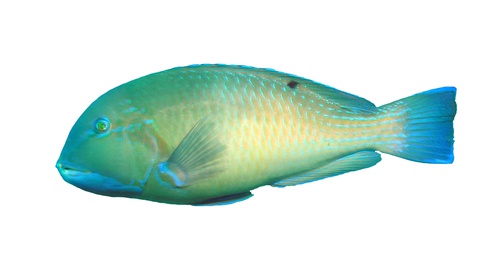Blackspot tuskfish
Choerodon schoenleinii

(Image credit: David Harasti)
Blackspot Tuskfish are protogynous hermaphrodites, meaning that they begin life as females and change sex to males once they reach a particular size, or if the dominant male of an area disappears.
In adults, females are a green/yellow colour and males are green/blue. The species gets its common name from the black spot that is found (in most individuals) on the upper body towards the rear of the dorsal fin. Each scale on the body has a vivid blue vertical line on the trailing edge. This line changes into a horizontal bar towards the tail, which roughly join producing horizontal bands along the base of the tail. A blue line is also present beginning at the upper mouth, crossing the eye and ending at the gills.
JUVENILES: Same colouration and pattern as adults. A white blotch-like marking is found behind the namesake black spot on the upper rear section.
A large set of canine-like teeth are present and are obvious when the tuskfish is feeding on hard shelled food items, such as urchins or molluscs. It has been observed overturning rocks while searching for food.
Length: Up to 1 m
Habitat
Outer reef; 10-60 m depth
Log it
Log if found anywhere in New South Wales
Related links/info
Species names on the Redmap site are based on the Codes for Australian Aquatic Biota or CAAB (http://www.cmar.csiro.au/caab/). This is updated regularly and lists the approved common name, family, species name and more.
Find further information and images at FISHES OF AUSTRALIA http://www.fishesofaustralia.net.au/











